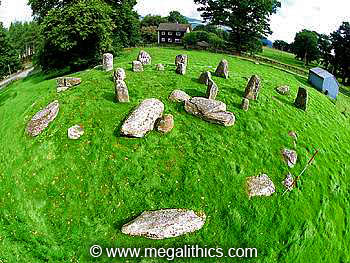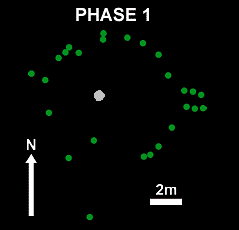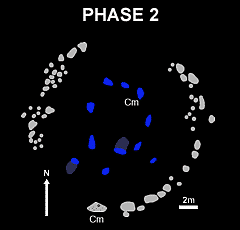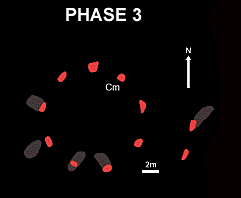
 |
Photo Gallery |
|
Panoramas |
||
Rock Art |
||
| NN 79756 47260 (GPS 56min) | Dia. 11.4m outer circle (Meas.) |
| Visited September 2001 | No magnetic anomalies |
Croft Moraig stands at the foot of mountains at the head of Loch Tay, the A827 passes the site less than 50m to the NW. Because of the remnants of the various banks, ditches and platforms, and the way the ground falls off around the site, it is difficult to get a good overview of the monument. If the true nature of the site is not known, it would be easy to suppose that this is some form of concentric stone circle. In fact, excavation in 1965 revealed Croft Moraig to be a complex and important site, the various phases of its construction a reflection of the changing needs and beliefs of the people who used it over a period of about a thousand years.
 The
first phase of construction at Croft Moraig was begun in the late Neolithic
around 3000BC with the erection of a roughly circular arrangement of posts measuring
7 x 7.9m. The holes left by these timbers were discovered during excavation and
their positions are shown as green circles on the plan to the left. The layout
of the posts has some interesting features, the most obvious being the two
closely spaced rows of posts at the east, this structure has been interpreted as
a formal entrance to the space enclosed by the posts. The main "ring"
of posts was set in a shallow circular ditch, but the two post rows of the
entrance were set outside of this ditch. Another notable feature is the open arc
at the south of the ring with a single post standing well inside the enclosed
space at the SSW. When viewed from the centre of the structure, the internal
post is aligned on the major southern moonset. At the southwest a roughly evenly
spaced row of four posts stands in a line tangential to the circle that the
"ring" posts stand on, the function of this feature remains a mystery.
A large flat boulder (shown in grey), was discovered near the centre of the ring
beside a hollow containing burnt bone.
The
first phase of construction at Croft Moraig was begun in the late Neolithic
around 3000BC with the erection of a roughly circular arrangement of posts measuring
7 x 7.9m. The holes left by these timbers were discovered during excavation and
their positions are shown as green circles on the plan to the left. The layout
of the posts has some interesting features, the most obvious being the two
closely spaced rows of posts at the east, this structure has been interpreted as
a formal entrance to the space enclosed by the posts. The main "ring"
of posts was set in a shallow circular ditch, but the two post rows of the
entrance were set outside of this ditch. Another notable feature is the open arc
at the south of the ring with a single post standing well inside the enclosed
space at the SSW. When viewed from the centre of the structure, the internal
post is aligned on the major southern moonset. At the southwest a roughly evenly
spaced row of four posts stands in a line tangential to the circle that the
"ring" posts stand on, the function of this feature remains a mystery.
A large flat boulder (shown in grey), was discovered near the centre of the ring
beside a hollow containing burnt bone.
 The phase two construction at Croft Moraig marks the transition from a timber monument to one of stone. The original timber structure was replaced by a ring of eight substantial stones with a further arc of three smaller stones just outside to the south. The new stone ring roughly followed the plan of the old timber circle and
was similar in size at 6.4 x 7.9m, it is often described as being "horseshoe" shaped. Whilst there is certainly
a wide gap between the stones at the south, the stones at the west have gaps of a similar size. When viewed today, the stones of the inner ring do indeed resemble a horseshoe, but this is because a stone at the south has fallen, if this were still standing we would certainly see a more circular
arrangement, this is obvious in the plan on the left. What is certain is that the stones of the phase two ring are graded in height
from 0.8 to 1.4m up towards the SSW, this is a common feature in stone circles with lunar alignments, most notably the magnificent recumbent circles of Aberdeenshire. This lunar association is further confirmed by an
alignment to the major southern moonset over both the middle stone of the outer southern arc and a large supine stone situated on the
other main phase two element, the outer bank. To be incorporated in both phases
of construction, the lunar alignment must have been very important to the
builders. The large stone on the bank is presently arranged with its long axis following the circumference of the bank, it is heavily decorated on its upper surface with rock art, bearing over twenty cupmarks, at least two of which have surrounding rings.
Cupmarked stones in stone circles often have astronomical alignments as this one does,
and this is also true for the other cupmarked stone of the phase two construction. The NE stone of the inner ring is also cupmarked and it stands close to an alignment with the midsummer sunrise over an horizon elevated by nearby mountains.
As mentioned above, the other major
component of the phase two monument was a bank, this was circular and constructed of stone
rubble retained by kerbs. At 18m in diameter, the bank surrounded the
stones of the phase two ring, whether
this encirclement was complete is uncertain as sections of the bank have been
robbed away at the SW and the north.
The phase two construction at Croft Moraig marks the transition from a timber monument to one of stone. The original timber structure was replaced by a ring of eight substantial stones with a further arc of three smaller stones just outside to the south. The new stone ring roughly followed the plan of the old timber circle and
was similar in size at 6.4 x 7.9m, it is often described as being "horseshoe" shaped. Whilst there is certainly
a wide gap between the stones at the south, the stones at the west have gaps of a similar size. When viewed today, the stones of the inner ring do indeed resemble a horseshoe, but this is because a stone at the south has fallen, if this were still standing we would certainly see a more circular
arrangement, this is obvious in the plan on the left. What is certain is that the stones of the phase two ring are graded in height
from 0.8 to 1.4m up towards the SSW, this is a common feature in stone circles with lunar alignments, most notably the magnificent recumbent circles of Aberdeenshire. This lunar association is further confirmed by an
alignment to the major southern moonset over both the middle stone of the outer southern arc and a large supine stone situated on the
other main phase two element, the outer bank. To be incorporated in both phases
of construction, the lunar alignment must have been very important to the
builders. The large stone on the bank is presently arranged with its long axis following the circumference of the bank, it is heavily decorated on its upper surface with rock art, bearing over twenty cupmarks, at least two of which have surrounding rings.
Cupmarked stones in stone circles often have astronomical alignments as this one does,
and this is also true for the other cupmarked stone of the phase two construction. The NE stone of the inner ring is also cupmarked and it stands close to an alignment with the midsummer sunrise over an horizon elevated by nearby mountains.
As mentioned above, the other major
component of the phase two monument was a bank, this was circular and constructed of stone
rubble retained by kerbs. At 18m in diameter, the bank surrounded the
stones of the phase two ring, whether
this encirclement was complete is uncertain as sections of the bank have been
robbed away at the SW and the north.
 The
final phase of construction at Croft Moraig was the erection of a further stone
circle outside of the Phase two ring, but inside the phase two bank. There are
nine stones in this circle and they are taller (1.75 to 2.1m high), and more
massive than the stones of the first ring. This last circle is a plain ring with
evenly spaced stones that show no height grading. Just as the first stone ring
incorporated the SSW lunar alignment, another feature of the earlier
timber monument was recreated in the third phase construction, the eastern
entrance. Two large stones each about 2.2m tall were placed 4.5m ESE of the
phase three ring, the northernmost aligned close to the equinox sunrise. Both
stones are described as "leaning dangerously" in the Piggott &
Simpson excavation report of 1971, and indeed, the northern stone has fallen
some time between 1965 and 1994. Pits had been dug in front of each portal stone
and these are interpreted as being burials that since disappeared in the acid
soil. There is no mention in the literature of rock art
on the stones of the phase three ring, but during our visit we noticed what
seemed to be cupmarks on the inner face of the NE stone of this circle. As can
be seen from our photos of these markings, some of them
seem to be well-formed cupmarks and their presence on the NE stone, immediately
adjacent to the cupmarked NE stone of the inner ring, increases the likelihood
that this is genuine rock art. We have reported this possible new
rock art to the local SMR.
The
final phase of construction at Croft Moraig was the erection of a further stone
circle outside of the Phase two ring, but inside the phase two bank. There are
nine stones in this circle and they are taller (1.75 to 2.1m high), and more
massive than the stones of the first ring. This last circle is a plain ring with
evenly spaced stones that show no height grading. Just as the first stone ring
incorporated the SSW lunar alignment, another feature of the earlier
timber monument was recreated in the third phase construction, the eastern
entrance. Two large stones each about 2.2m tall were placed 4.5m ESE of the
phase three ring, the northernmost aligned close to the equinox sunrise. Both
stones are described as "leaning dangerously" in the Piggott &
Simpson excavation report of 1971, and indeed, the northern stone has fallen
some time between 1965 and 1994. Pits had been dug in front of each portal stone
and these are interpreted as being burials that since disappeared in the acid
soil. There is no mention in the literature of rock art
on the stones of the phase three ring, but during our visit we noticed what
seemed to be cupmarks on the inner face of the NE stone of this circle. As can
be seen from our photos of these markings, some of them
seem to be well-formed cupmarks and their presence on the NE stone, immediately
adjacent to the cupmarked NE stone of the inner ring, increases the likelihood
that this is genuine rock art. We have reported this possible new
rock art to the local SMR.
 The
diagram to the left shows what is visible at Croft Moraig today, the circle
stones of phase two and three and those of the phase three entrance are all
visible, the majority of them still standing. The kerbs and larger stones of the
phase two bank are also very much in evidence and all of the rock art mentioned
above is visible. What is not visible is any evidence of the phase one timber
structure, also concealed is the fact that none of the stones at the site have
deep stoneholes, it appears that stones with especially flat bottoms
had been deliberately selected to give improved stability in shallow holes, the
stones being chocked in place with packing stones. Dense quartz scatters were
found in the northern part of the inner circle and just outside it at the north,
quartz was also found near to the northern portal stone, but of course none of
this is visible today.
The
diagram to the left shows what is visible at Croft Moraig today, the circle
stones of phase two and three and those of the phase three entrance are all
visible, the majority of them still standing. The kerbs and larger stones of the
phase two bank are also very much in evidence and all of the rock art mentioned
above is visible. What is not visible is any evidence of the phase one timber
structure, also concealed is the fact that none of the stones at the site have
deep stoneholes, it appears that stones with especially flat bottoms
had been deliberately selected to give improved stability in shallow holes, the
stones being chocked in place with packing stones. Dense quartz scatters were
found in the northern part of the inner circle and just outside it at the north,
quartz was also found near to the northern portal stone, but of course none of
this is visible today.
Easily accessible, in good condition and with so many
interesting features, Croft Moraig must be at the top of the list for
megalithically inclined visiting the Perthshire region.